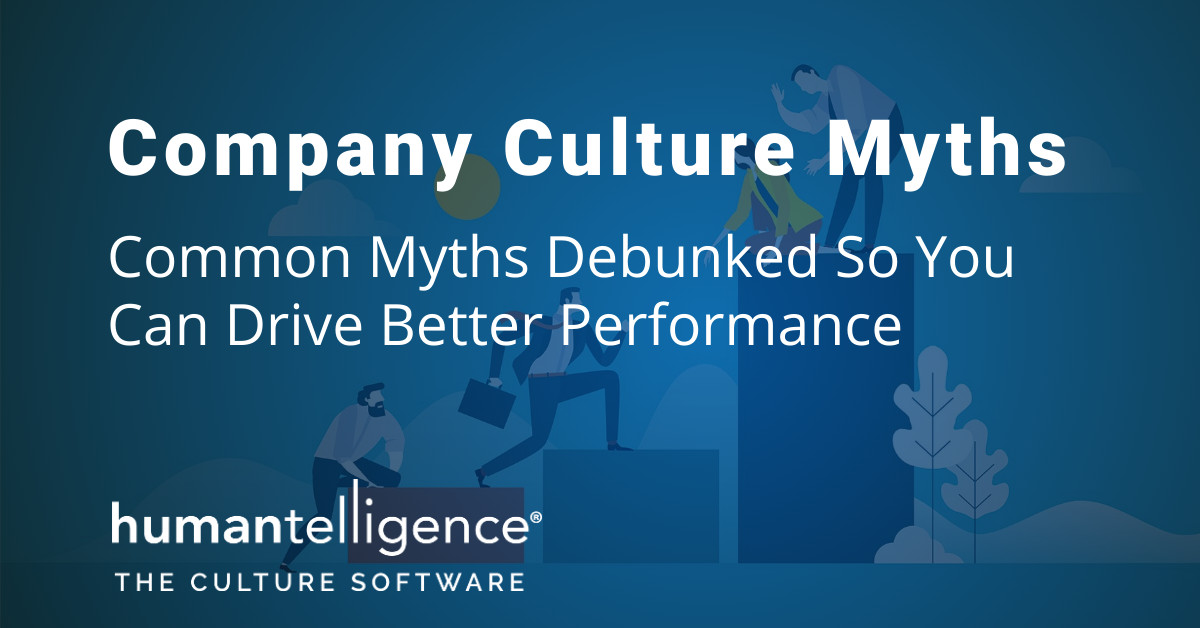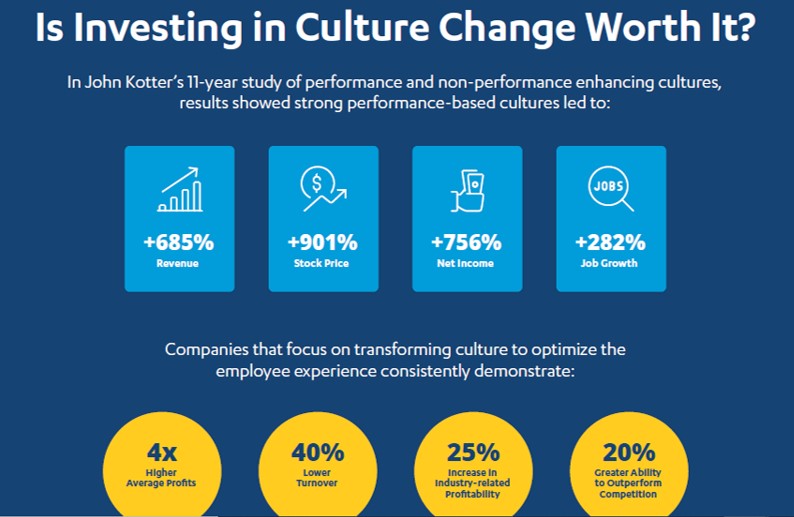Busting Company Culture Myths Drive Better Performance
- June 20, 2022
- Humantelligence

Navigating culture change is hard. What makes it harder are the long enduring company culture myths. Some are notorious for hindering a company’s success. By now, we all know culture is vital to a company’s success. When it’s good, company culture boosts the organization’s profile and distinguishes you from your competitors. What follows? Your culture attracts top talent, investors, and customers.
But as crucial as company culture is today, it remains misunderstood. That’s why we’re tackling some of the most common company culture myths so you can begin navigating culture change. Below, you’ll find our top five myths. To see all the myths debunked, download our eBook — 7 Company Culture Myths: Debunking Common Culture Myths in order to Drive Better Performance.
Myth 1: Company culture are your values and employee perks.
Many people believe that company culture is all about ping-pong tables, game rooms, catered lunches, happy hours, and open-door policies. On top of these perks, employees have amazing salaries and benefits. While a good paycheck and unique perks are substantial, they don’t make the culture.
Before identifying what makes culture, let’s understand what culture is not. For that, we turn to Don Sull. He tells us in When It Comes to Culture, Does Your Company Walk the Talk?, it’s not the values you post on your website or the laminated one-pager you give to employees. He goes on to explain that company practices often conflict with corporate values. There is little data demonstrating a correlation between official company values and actual culture as perceived by employees.
Company culture is how work gets done in the organization, who makes the decisions and why, how people are rewarded, and opportunities to grow through leadership and mentorship — all of the behaviors, expectations, values, and norms associated with working at your company. Put more succinctly, culture is your company’s B-M-W: the sustained patterns of (1) Behaviors over time that are supported by the shared experiences, (2) the values or Motivators, and beliefs of the organization, and (3) the way work happens or Work energizers of its people.
Together, culture is what transforms individual employees into a collective, cohesive whole. And all the perks, benefits, and fun stuff are just the cherries on top!
Myth 2: Investing in and navigating culture change is difficult because the connection between culture KPIs and business objectives is unclear.
You can develop the most exceptional product in the world. What’s going to make it stand out and turn a profit are your people. They are your power source. Culture is the strategy- and performance-enabler, and if you don’t align your culture with your business goals, how can you expect your people to help you achieve them?
When aligned with business strategy, organizational culture drives results, without having to rely on command and control. There have been several studies — including John Kotter’s 11-year study of performance- and non-performance enhancing cultures — that indicate correlation between strong performance-based cultures and positive business results:
- +685% Revenue
- +901% Stock Price
- +756% Net Income
- +282% Job Growth
Companies focused on cultivating culture consistently demonstrate:
- 4x Higher Average Profits
- 40% Lower Turnover
- 25% Increase in Industry-related Profitability
- 20% Greater Ability to Outperform Competition
Plus, studies find that 40 percent of employees report that they benefit when their own goals are in step with their company’s goals.
Navigating Culture Change with Quick Wins
But when you’re on a tight budget, it may not seem like investing in company culture is possible. That’s another company culture myth because there are affordable ways to improve your company’s culture. Some of those include developing and infusing emotional intelligence into workplace communication or providing your team with training opportunities.
Ultimately, culture is set by its leaders, starting with the founders, CEO, or executive leadership. Alexander Nicolaus, Chief People Officer at Paysend and author of Startup Culture: Your Superpower for Sustainable Growth, recommends getting specific:
“Define your organization’s why, who you are, and who you want to be. Your behavior sets an example for the rest of the team, and the rest of the team ends up modeling it, which then builds the culture.”
Myth 3: Employee feedback is the key to navigating culture change & solving problems.
While employee feedback does provide some insight into the employee experience, it’s not the measure of company culture.
Here’s the problem with engagement surveys: The data you get from a survey is often circumstantial, one-directional, and predicated on an individual’s personal perceptions, feelings, or emotions. Feedback collection cuts out the full scope of interactions — only capturing a narrow vantage point and perspective.
What’s more, you may not always receive honest feedback from your team. Would you be completely comfortable, even if anonymous, telling your superior what’s wrong with their management style or the business?
If you want real feedback from your team, you first need to build trust with them. Further, you need to understand that employees’ recommendations aren’t personal. Instead, these are suggestions that could improve your business.
A healthy workplace culture will be sculpted by the values, behaviors, and interactions between stakeholders, from senior leaders to the front-line and back again. It’s identifying and measuring those that will allow you to fix the culture. The employee experience follows.
Myth 4: There’s no such thing as quantifying or measuring company culture.
Traditionally, company culture dynamics have been easy to sense — like a state of mind — but difficult to measure. While culture as an idea cannot be easily quantified, a positive company culture produces a set of behaviors that are trackable. The outputs of a healthy and productive company often can be quantified. These are the components that can be measured in a comprehensive way.
By leveraging AI-powered Culture-as-a-Service (CaaS) solutions, you can unlock actionable insights around critical psychometric traits of team members and gain a total picture of one’s behaviors, motivators & values, and work energizers. When you aggregate this kind of assessment data, you then can:
- Map current vs. target cultures for teams or the entire company
- Pinpoint strengths and gaps to identify necessary shifts
- Hire and promote using data to identify fit and predictive success
- Enable better collaboration in order to drive performance
Power teams to deliver results from wherever they work
You can compare under- and high-performing teams and then culture map core values to your team’s measured motivators, behaviors and ideal work environments to gauge alignment. This lets you build an action plan to achieve your desired company culture.
Myth 5: Once your company culture is established, it’s usually too hard, if not impossible, to change or transform it.
Organizational culture takes root through the values, associated behaviors, and interactions between individuals within an organization. If the core principles by which an organization’s team members should operate are not predefined and measured, leaders and team members will behave in ways they subjectively believe to be right.
These personal beliefs are usually the product of learned behaviors and experiences that may be misaligned or inconsistent with driving a sustainable and results-oriented culture that is right for your business.
We frame this as the difference between “managed vs. organic culture.” A managed culture ensures that the right values and associated behaviors manifest throughout an organization. It ensures the right leadership practices and organizational activities are in place to reinforce these values through practical actions and decision-making tactics.
The Case for a Managed Company Culture
In a managed culture where you track organizational identity, you’re able to make more informed personnel decisions and take steps to navigate culture change. For example, there might be times you need to decrease the size of your team if you want your business to scale — like they did at Grasshopper (acquired by Citrix).
“At one point, we had 65 employees and a huge payroll,” said co-founder Siamak Taghaddos. “It was hurting our ability to grow our business and focus on marketing. We learned it was easy to go from $5 million in revenue to $10 million, but hard to go from $50 million to $100 million.”
By standardizing its culture and streamlining its hiring processes, which was built around a set of values and team building, the company reduced costs and became more efficient. “We could see who on our team wasn’t radically passionate, and who wasn’t necessarily entrepreneurial,” said Taghaddos. “It helped us in doing employee reviews and shaped our hiring.”
A managed company culture means that senior leaders of an organization make a deliberate and purposeful effort to define the values that drive the organization’s mission and vision. They define how it serves internal and external stakeholders in order to achieve defined business outcomes.
These are just five of the most common company culture myths. Get the full listing of myths and learn how navigating culture change at your organization can lead to better team performance. And if you’re ready to bust through your company culture barriers, we can help. Let’s set up a time to discuss your goals and how we can help you achieve them.
